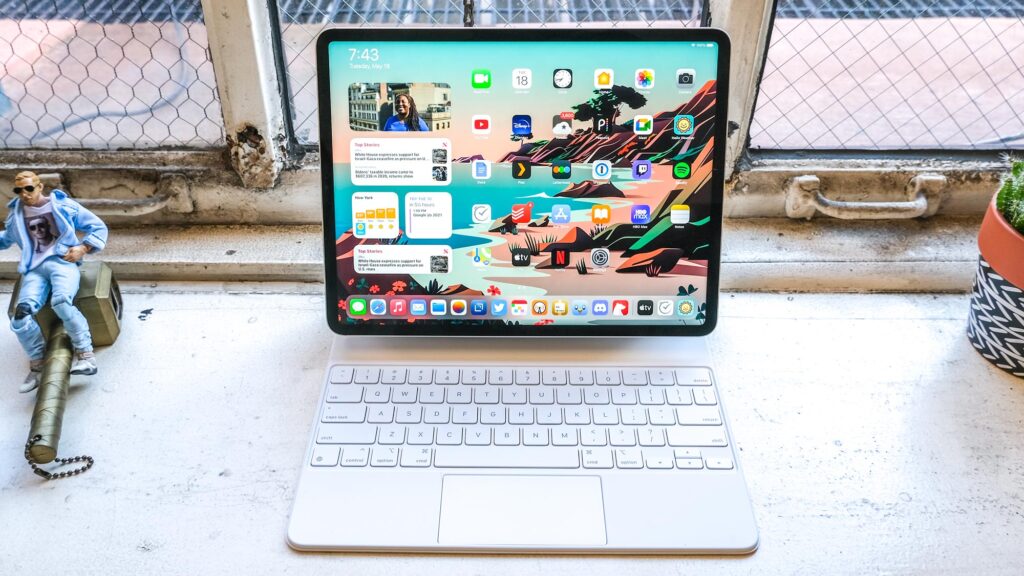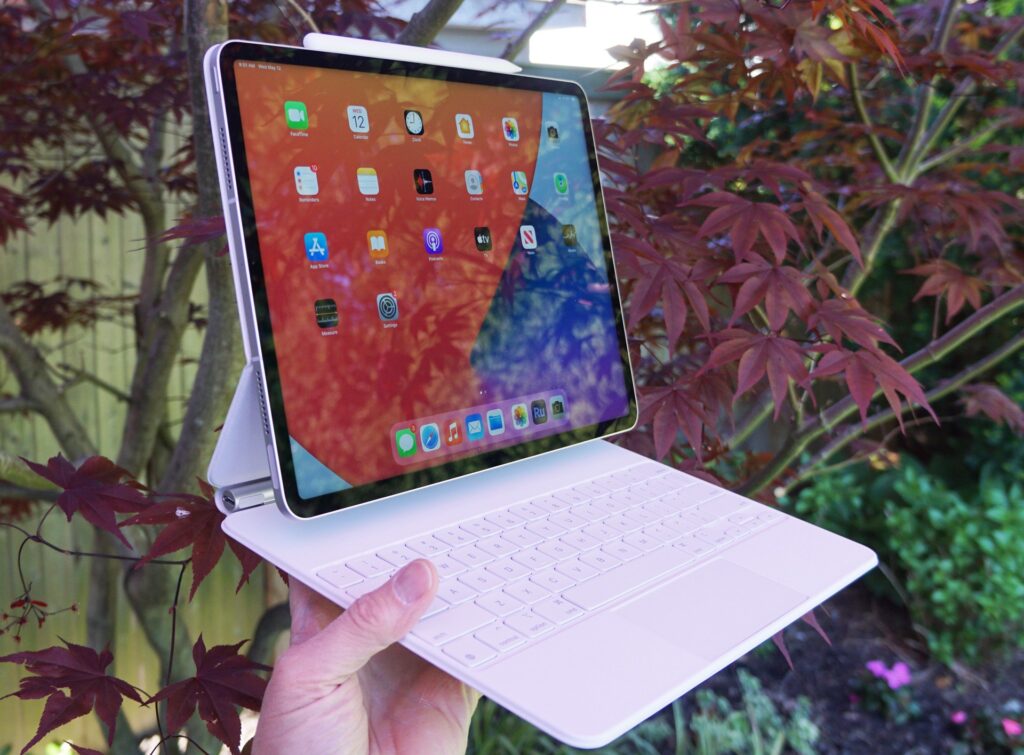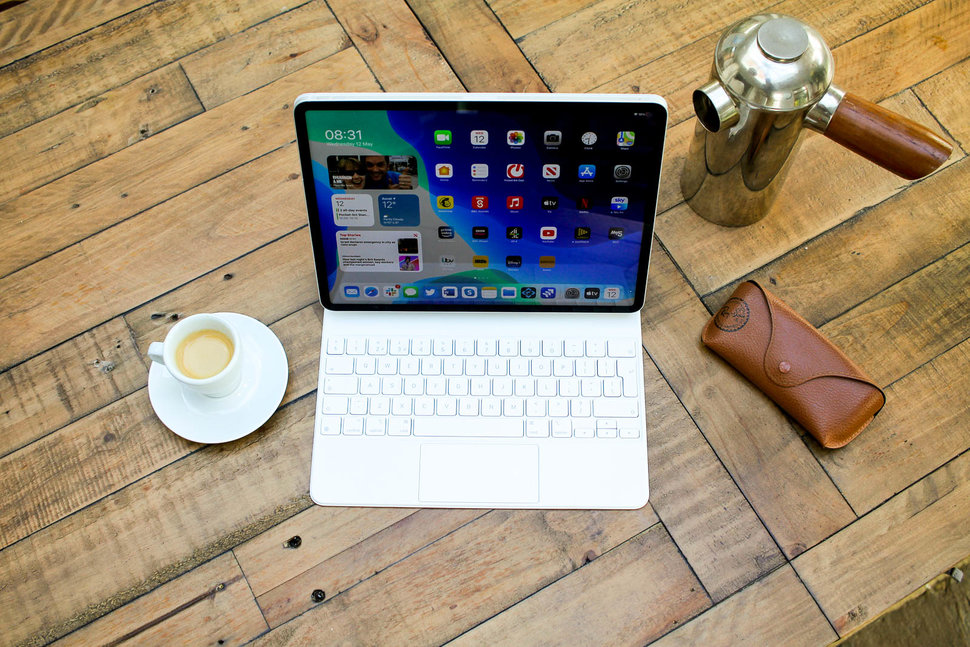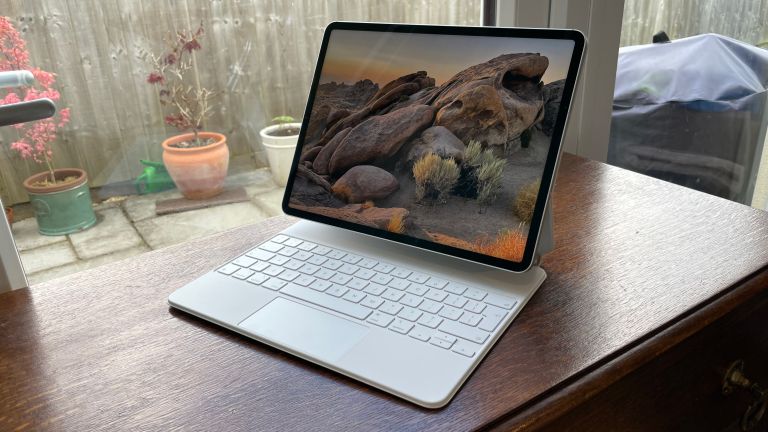With its sleek, neat, and efficient design, the iPad Pro showcases a fairly incredible new screen, which does not, however, manage to hide that the most dazzling innovation is the presence of SoC M1, the same chip that thrills the first Apple Silicon Macs.
Apple iPad Pro 12.9 Specification
Platform
System: iPadOS 14
Processor: Apple M1
RAM: 16 GB
Available storage capacity: 1000 GB
Memory card support: No
Display
Size (diagonal): 12.9
Screen definition: 2732 x 2048
Screen resolution: 265 dpi
Screen technology: LCD
Features
Wi-Fi support: Yes
Wi-Fi standard: 802.11a Wi-Fi, 802.11b Wi-Fi, 802.11ac Wi-Fi, 802.11g Wi-Fi, 802.11n Wi-Fi, Wi-Fi 6
Bluetooth support: Yes
Bluetooth version: Bluetooth 5.0
NFC support: No
USB connector type: USB Type-C
USB HOST: No
GPS
GPS chip: Yes
Camera
Main photo sensor: 12 MP
Communication
No Phone function but support 3G, 4G, 5G
Dimension
Width: 28.06 cm
Height: 21.49 cm
Thickness: 0.64cm
Weight: 684g
Apple iPad Pro 12.9 2021 1TB Wi-Fi + 5G
Sometimes an actor is so in the lead that it’s hard to judge his progress. This could be the case with Apple and its iPad Pro, with no real rival in the world of pro tablets. Even while eyeing the side of hybrid PCs. A situation that is as much a result of the positioning of Apple’s product, as of the reality of different hardware. And software ecosystems in the PC / Windows world.
However, with the iPad Pro M1, Apple has given birth to a product that is difficult not to see the evolution in leaps and bounds. From the display, a traditional strong point of Apple products, to the M1 chip that drives it. Everything shouts loud and clear that this iPad Pro is there to dominate the competition. And to further erase the border that sets it apart from MacBooks. More exactly, this iPad Pro continues to dig its third way between tablet and portable “PC”. It reinforces its versatile approach to personal and professional computing. Arrogates to itself the right to inaugurate mini-LED screens. While now playing with the same cards as Macs… except for a few details.

Mini-LED screen: brightness and contrast
The exterior design of the iPad Pro remains unchanged, with fairly discreet screen borders although present. Vertical edges that are assertive and comfortable to handle. We note just a few tenths of a millimeter more in height, width, and especially thickness.
This last gain arrival of the new technology on the display side. Because yes, one of the big novelties of the 12.9-inch iPad Pro 2021 is in five words. And a lot of development efforts, we imagine mini-LED and Liquid Retina XDR. Those who follow the adventures of the Cupertino company with attention will have recognized. The name introduced with the professional screen from Apple, the Pro Display XDR.
But these three letters are much more than an economic denomination, they imply the respect of certain technical requirements. Thus, the panel must display a brightness of 1000 nits per cd / m2 when displaying HDR content. Peaks of up to 1600 cd / m2 can also be ensured when displaying some HDR photos. We measured them at 1531 cd / m2. Likewise, the required contrast ratio is extremely high (1,000,000: 1), close to an OLED panel. With reputedly infinite contrast offers since the black pixels do not emit any light. Strict specifications, therefore.
Screen
Our screen measurements partially confirm these theoretical figures. We recorded a base brightness of 606 cd / m2 (excluding HDR content). Which is very close to what the panel of the iPad Pro 2020 offered. And suggests that the 1000 nits are indeed guaranteed in the conditions. set out by Apple. We also noted a contrast ratio of “only” 60,600: 1, still on non-HDR content.
The use of quotes is important because it suffices to compare this score with that obtained. With the panels of the previous iPad Pro to realize the giant leap that has just been made.
Obviously, the mini-LED is at the heart of this progress. The more than 10,000 LEDs at work behind the display are grouped into more than 2,500 backlight zones. Giving better control of light scattering, showing much deeper blacks. And limiting effects unwanted such as blooming. Note, however, that we have noted some traces. This was particularly the case during films when subtitles were displayed on a particularly black background. Nothing catastrophic or crippling, obviously. But it’s worth pointing out and doesn’t undermine the fact that these display advancements are aimed. At enabling professionals to maintain an HDR production line from start to finish.

Color coverage of the iPad Pro M1, RGB space.
Obviously, the arrival of the mini-LED does not eliminate the technologies that Apple has developed over time. We, therefore, find the True Tone, which adjusts the white balance of the screen to the ambient light. In order to guarantee better comfort for your eyes. ProMotion, which varies the refresh rate of the panel from 24 to 120 Hz, is also there. At work so that the display fluidity adapts depending on whether you are watching a movie or playing Fantasian.
P3 technology, for a very wide color gamut, also always answers the call, and guarantees nuanced, rich, and faithful colors. Our measurements of Delta E 2000, which establish the difference between a displayed color and its true value. Show that Apple continues to excel. The 2020 iPad Pro gets a 2.2, in line with, a few tenths. What the two previous 12.9-inch Pro models offered.
You will understand that drawing, watching a movie, or playing on the iPad Pro is extremely pleasant. Especially since for these last two activities, the four stereo speakers greatly contribute to the immersion. Mini-LED backlighting technology does save the 2021 model a few hundredths of a millimeter, but this relative overweight is excused. The Liquid Retina XDR panel is a marvel.

Powerful, like a Mac M1 …
But surprisingly, this is not what is getting the most attention. There is something amazing when you think about it. About finding the same chip in this iPad Pro that we discovered in the Macs ( mini, MacBook Air, and MacBook Pro ). Launched late last year, and in the recently arrived 24-inch iMac. It would be as if Apple had found the one-size-fits-all solution, the weapon of mass production.
An SoC with a performance/energy consumption ratio sufficiently optimized to fit. In a relevant way – into a wide variety of form factors. Because, apart from the addition of an active cooling system in certain devices, such as the MacBook Pro. The Mac mini, or even the iMac, the M1 chip integrated into all these devices and in the iPad Pro 2021 is identical. It arrives with its eight CPU cores (clocked for the most efficient at 3.2 GHz) and eight GPU cores. Its 16-core neural processor, and its maximum unified RAM limit, set at 16 GB.

8 or 16 GB of memory?
For the first time, Apple is offering two amounts of RAM for the same iPad Pro format. This calls for some clarification. When we ask Apple about the potential differences in performance between an 8 and 16 GB model. We are told that there are obviously some, but not necessarily as we understand it. Except in the very specific case of a particularly demanding application. The performance in a single task use will not vary. Where the 16 GB will make the difference is in the capacity of the iPad Pro. Just to keep more programs active in the background. To maintain a slightly higher responsiveness in the OS in general.
In addition, for the future, with the rise of applications, in particular. Those which use Metal and machine learning functions. Opting for a model with 16 GB will guarantee better performance.
In other words, opting for the iPad Pro 2021 with 16 GB. Namely, the two models with 1 and 2 TB (sold respectively from 1989 and 2429 euros) are only relevant. Apart from the storage capacity – if you use very demanding applications. Are a champion of multitasking or bet on the long term.
Memory
The fact that Apple has chosen to reserve this memory capacity for the most expensive models could (unfortunately) also make your choice easier.
After carrying out our usual tests, with our various tools, we, therefore. Decided to compare the performance of the 2021 iPad Pro with that of these two older siblings of the same format. The 12.9-inch iPad Pro 2018 (equipped with a chip A12X Bionic, and 6 GB of RAM). And 12.9-inch iPad Pro 2020 (with an A12Z SoC, also with 6 GB of RAM). For good measure, when possible, we added in the loop the MacBook Air M1, tested last November. Which therefore included an M1 and 8 GB of unified memory. The ultraportable has the advantage of not carrying a fan either. Which places it in a configuration quite close to that of the iPad Pro, with the obvious difference in the form factor.
With Geekbench 5, what do we see? First thing, that the iPad Pro 2021 displays almost identical performance to that of the MacBook Air. In other words, Apple makes sure that the power is not an argument of distinction between these two products. It is the versatility of the tablet, its ergonomics, the performance of its OS. And the accessories that will make you choose it over the MacBook Air if you are convinced. Like nothing, Apple is putting some pressure on itself by doing this. Because iPadOS is really going to have to improve greatly to make the iPad Pro more than an excellent tablet. But also a laptop capable of competing with a MacBook Air running macOS Big Sur. We will come back to that.

iPad Pro 2021: what is the Apple M1 worth?
Second point of observation, the iPad Pro 2021 largely dominates its predecessor. With respectively 53.7 and 55.5% performance gain in single and multi-core. The case is heard, the M1 is much better than the A12Z.
When we look at Metal performance, from the graphics part to put it simply. The gain goes to 115.5%, so it is more than a doubling of the capacities of the iPad Pro 2021 in this area.
To moderate these figures a little, if we look at AnTuTu 8, we observe slightly less good progress. For the overall score, however, a plus 39.1% is recorded. While for the various detailed sub-scores, the gains oscillate between 35.5 and 47.2%. This last result attribute to RAM. The quantity of which more than doubled between our two test models.
Apple is also increasingly emphasizing the capabilities of the neural network integrated into its SoCs. The use of machine learning is strongly encouraged among developers working in its ecosystems. We, therefore, compared the three generations of tablets with a new tool, Geekbench ML. Which measures the performance of machine learning algorithm computation with the processor. The graphics processor, and with Core ML, the tool made available to developers. by Apple.
Here again, the iPad Pro 2021 largely dominates the 2020 model. CPU and GPU side, these are gains of around 44% that we record. While the Core ML part shows a plus 90.2%. Apple is therefore serious when it says that its M1 chip optimizes to give the best of itself for uses. And functions based on the use of “artificial intelligence” algorithms.

Power and thermal limit
We will complete this avalanche of synthetic tests with 3Dmark Wild Life. A benchmarking tool that has several advantages. Not only does it estimate the graphics capabilities of a platform, but it also incorporates a stress test. It is in fact a matter of running the same grueling test in a loop, for about twenty minutes, and then of noting the differences in performance between the results obtained at each rotation. A stability score is then assigned to the tested devices.
When we subject the iPad Pro 2021 to the first part of this test, it conscientiously crushes its elders, with a score almost 70% higher. We can therefore applaud the M1. However, all is not rosy – by the way, the iPad Pro is only available in space gray and silver.
Because, when we look at the results of the stress test, we see that the amazing performance of M1 is no longer the order of the day. The scores obtained for the best and worst test loop by the iPad Pro M1 are between 49.5 and 57.6% lower than those recorded with the iPad Pro 2020, with its A12Z.
A difference in behavior in the face of throttling (when a processor reduces its performance because it heats up too much) summarized by the stability score attributed by 3Dmark Wild Life: 95% for the iPad Pro 2020… 79.8% only for the 2021 model.
Apple M1
It seems that we are therefore reaching the limits of the magic of the M1 with the very compact case of the iPad Pro.
Nevertheless, once detailed all these test results, it is obviously necessary to give a little feeling “of the daily”. The famous “iPad experience” is assured without a hitch. The interface is fluid, the applications launch quickly, even the heaviest. The best-known productivity apps run without the iPad Pro even seeming to have to exert an effort. The games run with ease and ease. The use of a controller is strongly recommended, especially since it is now possible to synchronize the gamepads of the Xbox Series and PlayStation 5, in addition to those of the previous generation consoles. No more excuses not to chase coins in Crossy Road Castle for four or to explore the all-new Fantasian, the latest game from Final Fantasy creator Hironobu Sakaguchi.
In short, you will understand, the iPad Pro 2020 was not lacking in power, its successor raises the bar even higher, with a caveat, and should hold the course for a long time to come.

Autonomy, progress where it is needed
Traditionally, when you slip an ultra-powerful setup into a compact and portable device, a worried eye turns to the battery life result, because performance and endurance don’t mix very well.
The collateral effect of the “magic of M1” or more sure of the frenzied work of Johny Srouji’s teams, the case of the iPad Pro 2021 is an exception.
It is true that in video autonomy, which sees the iPad streaming a file until its battery gives up, we note a decline of just under an hour, the 12.9-inch iPad Pro M1 holds 10:42 a.m., compared to 11:39 a.m. for the previous generation.
On the other hand, when we turn to our versatile autonomy tests, which intensively simulate our daily uses: Web, video, etc., we see very clear progress between these same two models. The new iPad Pro M1 lasts 13:32, where its predecessor died at 11:49.
As you can see, in any case, the iPad Pro 2021 does better than the iPad Pro 2018, equipped with the A12Z.
Beyond these tests, in use, if you do not abuse the brightness and 5G (Wi-Fi remains the most energy-efficient), your iPad Pro should accompany you for a good part of your day. to work, play quietly, listen to music, and watch a few series.
Finally, be aware that if the iPad Pro 2021 is not one of those devices that recharge from 0 to 100% in less than an hour, it is also progressing slightly in this area, since it only takes 2h49 against 2h58 previously. Progressing won’t change your life, but a few minutes saved is always a good thing to take.

So a laptop?
All of this leads to a question, always the same when you consider the iPad Pro across Apple’s offering: is it capable of competing with MacBooks? Can he replace them?
If we put aside the thorny issue of price, we must take into account several points, which could be classified a little quickly under the name versatility.
Because, now that the iPad Pro shares the same chip as the last entry-level MacBooks (Air and Pro 13 inches), the question of the possible difference in power is largely resolved. We must therefore consider the possible uses with all the more attention.
However, on paper, and in fact, the iPad Pro 2021 is much more versatile than a MacBook Air. Let us list some more or less essential points which can motivate a choice.
There is of course the touch, to begin with, with the possibility of using a second-generation Apple Pencil to take notes or draw, two activities unthinkable on a Mac, without using at least one external tablet.
Unlike Macs, the iPad Pro also benefits from a cellular connection. Better, for the first time, the Apple tablet is compatible with the 5G standard, in addition to 3G / 4G – admittedly, compatible mobile networks are still in their infancy, but the iPad Pro can in fact stay connected. to the Internet even when it does not have access to a Wi-Fi 6 network. For users who travel regularly, this point can therefore be important.

The Thunderbolt / USB 4 port is obviously used to power the iPad Pro M1, but also to connect many peripherals.
The addition of Thunderbolt / USB 4 support also opens up the iPad Pro to new accessories and therefore new uses, further integrating the tablet into certain productivity cycles.
Thus, being able to connect high-performance external hard drives makes it easier to consult heavy documents on the move, for example, if we imagine that the iPad Pro is the terminal that a professional wants to take with him rather than a MacBook Pro.
Likewise, it is now possible to connect a 6K screen (at random, the Pro Display XDR) to the iPad Pro, with the limit that it is the applications that manage individually if this second screen is a mirror of what is displayed. on the tablet or an extension of the display surface. On this point, we would like the OS to take the lead to offer a unit of experience.
The rise to 2 TB of storage space also pleads in favor of an iPad Pro which is not only a terminal of limited consultation or creation. With such a capacity, it is quite conceivable to store 4K rushes by shovel, professional photos for a first edit, or even 3D models, tweaked or reviewed during a journey.
Camera
In a pandemic world, the iPad Pro also incorporates a much better front camera to ensure hours of professional and friendly video conferencing, which are not going to be definitively replaced by face-to-face meetings in the immediate future. Moreover, the new TrueDepth module of the iPad Pro 2021, an ultra-wide-angle associated with a 12 Mpixel sensor, offers a viewing angle of 122 degrees which allows the introduction of a useful and fun novelty: Center Stage.
This automatic function ensures that when you chat in video conference via FaceTime or equivalent, the framing will follow you to place you as much as possible in the center of the field. So you can move around a bit in your seat or move around the room without immediately getting out of the frame.
Small demonstration of Center Stage and its follow-up.
Obviously, the TrueDepth camera is not motorized to move, it will no longer follow you if you move too far to the sides.
In addition, the new front module adds Portrait mode to its arc, so it is possible to take advantage of the bokeh effect or the different lighting modes that recent iPhone users are now accustomed to.
To stay in the world of cameras, and if we look at the back of the iPad Pro, there are always two modules: a wide-angle (12 Mpixels) and an ultra-wide-angle (10 Mpixels) capable of filming in 4K. This can turn the iPad into an add-on camera or camera, not necessarily for photographing your vacation, but for quickly scanning a document, photographing an object to embed in a file, etc. A flexibility that is not offered by MacBooks without the intervention of an iPhone.
And that’s without counting also on lidar and augmented reality experiences, educational and fun, for the general public, and for the purposes of productivity or creation for professionals.
Apple‘s Magic Keyboard is now available in white.
And since we’re talking about productivity, let’s take a look at the Magic Keyboard, an accessory (unfortunately not very versatile) that physically transforms the iPad Pro into a laptop. In addition to the 2020 model being compatible with the iPad Pro 2021, the new generation of keyboards offers the same backlit typing comfort, the same flexible and rather a short stroke, and the same gestures via its trackpad. We will just be surprised at the existence of a white keyboard shell. As much as we can consider not spilling a slice of chocolate on the keys, it seems difficult to preserve the outer part of the shell from the usual dirt from the bag bottoms.
From a physical point of view, the Magic Keyboard finishes making the iPad Pro a MacBook killer, but this year again, it is the software, iPadOS, in this case, which will make us express reservations. Even when working task after task, switching little from one application to another, or worse from several applications to several others, we do not find the efficiency offered by the free and floating window of macOS. Everything is there, the touch screen or the keyboard and the trackpad when it’s the fastest solution, but there are still a few small things missing on the side of the iPad OS interface.
And, then, we can also remember that, unlike macOS which leaves a great deal of freedom – especially on the origin of applications or the choice of browsers, iPadOS is much more locked and quick to control our impulses.
So, once again, is the iPad Pro a good possible replacement for a MacBook? The answer is more and more “yes”, and the “but” smaller and smaller.
We are here to hear from you
Of course, you can contact us to let us know if we are missing something on our stepphase.com page. I hope you like it and by the way, thank you for your visit.








GIPHY App Key not set. Please check settings